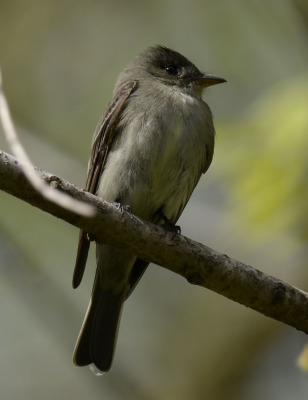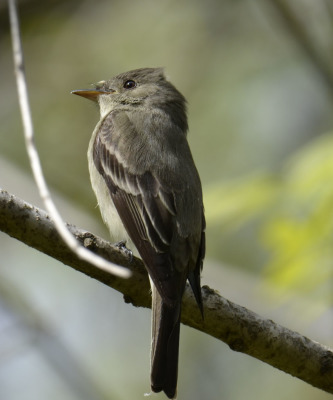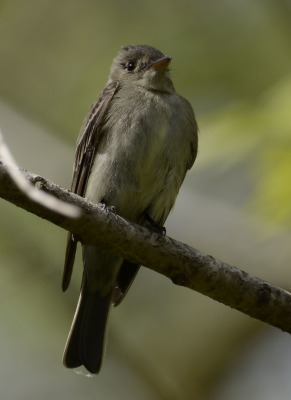There are several small flycatchers that live in Ontario during the months when flying insects are plentiful. Unlike the warblers, they don’t come with any handy flashes of colour to make identification easy. In fact, two of them look so much alike that even ultra-experienced bird watchers don’t try to name which kind they are unless they hear them call. I don’t know those two by call, but I do know one: the Eastern Wood Pewee.
Who Says Its Quieter for Sleeping in the Wilderness?
Anyone who has camped or cottaged in a forest in the summer will agree that it is not quiet in the woods even at night. And starting about an hour before true dawn, it can get downright noisy. Many birds sing out their territories in the grey light and one of them is the Eastern Wood Pewee. I’ve heard their Pee-a-wee…Pee-eeeewwwwww many times while trying to decide whether to get up and canoe on misty summer mornings. The second part of the call is a falling vaguely sound call as if they are disappointed. It’s very easy to memorize if you hear it a few dozen times.
You can hear recordings at the Cornell AllAboutBirds website. The site also says that it is the male birds that make this call. If that’s always true, then the bird whose photos you see here is a male.
And it’s a good thing their call is memorable because their colouring is not. As you can see from the photos they are a dull greenish-grey colour on the back, wings, tail and head, and a lighter colour on the front with a greyish upper half. The orange-ish lower bill is about the only colour on the birds.
They have two wing bars and no eye ring.
I wouldn’t be confident enough to post these photos with a name except this Pewee was calling steadily while I took them.
What Do Pewees Eat?
He was actively catching the gnats or midges that swarm in the parks along Lake Ontario in May. In fact, if you can see from the photos, this bird even has some bits of spider webs near its bill and tail.
When hunting, many small flycatchers have the same type of flight: they perch, preferably on a bare twig or branch, then dart out after an insect, often hovering briefly while they grab it, then perch again. It makes it easier to find them even after the leaves come out later in the spring.
Pewees most often take insects off of leaves and twigs rather than in mid-air.
According to the Cornell website, they also sometimes eat berries including blueberries. Smart birds!
It was nice to see one of these small birds down low enough to photograph. It was migrating through a park near Lake Ontario at the time. The ones I hear near dawn tend to perch thirty feet or more up making it harder to get a good look. I’ll still enjoy listening to them later this summer though. Who know? Maybe I’ll even hear this exact same bird!
Related Reading
- Identifying Eggshells from an Empty Nest
- Friday’s Friend
- Blue-Grey Gnatcatchers in Thorny Situation
- Out on a Limb
Join In
Do you listen to the morning chorus in the spring and summer? Are any calls memorable for you? Please share your experiences with a comment.



